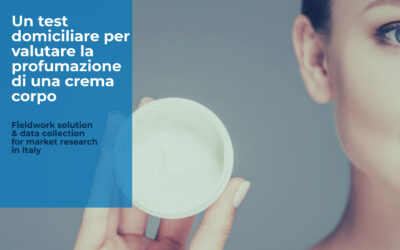Do you need to set up a product placement? Choose Testpoint
Discover the services of a modern agency dedicated to today’s market researchers.
Get a free quote
What is the “product placement”? A case study
The product “placement” is a fundamental moment of a home product test: the products to be tested are delivered to the respondent’s home, accompanied by adequate instructions regarding the order in which products have to be tested and a questionnaire to be completed after each usage.
Home placement is used when there are several products of the same type to be tested and compared: in this case, it is convenient to deliver all the products to the home of the respondents who were recruited for the test. The “placed” products – that is, the products delivered to respondent’s home – are always all of the same type because the test implies a comparison, and they can be either de-branded (i.e., without brand label and in anonymous packaging) or branded.
Our experience
A home usage test to evaluate the fragrance of a body cream
Recentemente, Testpoint ha svolto a Milano una interessante ricerca di mercato per determinare quale fosse la fragranza più gradita per una crema corpo idratante. Si trattava di una crema di fascia alta, di quelle vendute esclusivamente in profumeria. La crema era...
A test on new flavours for e-cigarettes
Recently, Testpoint selected the participants in a very particular market research: it involved users of electronic cigarettes, or in any case to people open to use electronic cigarettes, who received kits made up of devices and sticks...
Creme idratanti – 80 donne le testano a domicilio
Recentemente, Testpoint ha selezionato 80 giovani donne per un test a domicilio su prodotti cosmetici. Si trattava di testare tre diversi campioni di creme idratanti. Il test si è svolto in due diverse città, Roma e Milano. Vi interessa saperne di più? Vi raccontiamo...
A test with product placement of spaghetti
What cannot be missing on the Italian table? The pasta! Testpoint recently carried out a research to evaluate the satisfaction about some types of spaghetti by sending the package with the samples to the home of the respondents recruited for the research and inviting them...
“Placement” methods
Product placement can be carried out in different ways:
- A parcel containing the products can be delivered to respondents’ homes: in this case respondents receive the different products, test them in the required order and for the required time (for example, one week for each product), complete the online questionnaire after testing each product. Sometimes, to collect the data, you may have telephone interviews instead of online self-completed questionnaires.
- The products can be delivered to respondents’ homes by an interviewer who delivers the product, then returns for the post-use interview and delivery of any second product. The procedure is repeated for all the products to be tested. In some cases, it is possible that the interviewer deals exclusively with the placement of the product, with the respondent who self-completes the online questionnaire.
Product placement can also take place at a central location: in this case, respondents are required to visit the central location, pick up the product, test it for the required time, self-complete the online questionnaire at the end of each test. Of course, this methodology is recommended when there are few products to be tested.
Different methods for the same methodology
These different methods do not affect the methodology: it is always a home usage test. But when is one method better than the other?
The interviewer is used when for some reason an administered interview is preferred to a self-completed questionnaire. Furthermore, the placement of the products through the interviewer with respect to the delivery of the products by courier guarantees that the respondent tests the products in the right order, without errors or confusions that could be possible when the products to be tested and compared are more than two or three.




